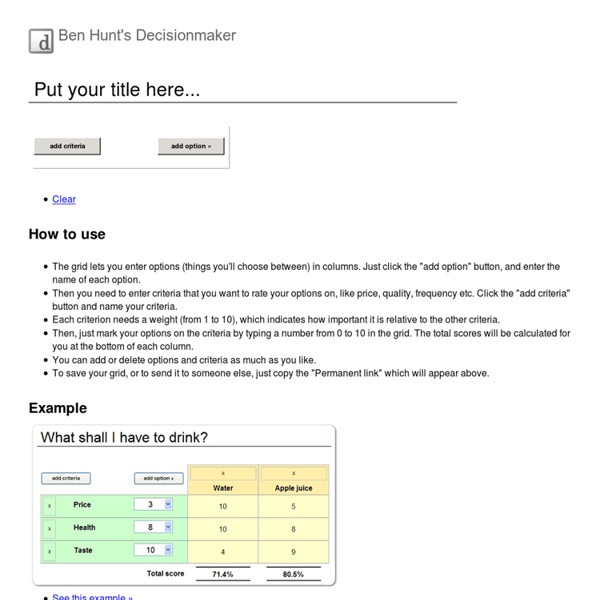



http://webdesignfromscratch.com/decisionmaker/
Related: musicThe Cube Game - Find Out The True Nature Of People In this video I am going to play with you The Cube game. This psychological game is from the book “Secrets of the Cube” . Even If You Know About The Gorilla, You Might Not Catch The Unexpected There's a very famous perception experiment, which many of you have probably seen. If you haven't, you should watch it here before reading on: I will admit that the first time I saw it (at a conference), I totally missed the gorilla. Totally. Of course, once you've seen it or know about it, it's hard not to see it. The Business Case against Business Cases Companies that rely on traditional project management methods could be getting an incomplete picture of their own vulnerabilities and opportunities. Imagine this: You’re standing in front of the committee that approves investments, palms sweating, hoping that the audiovisual equipment doesn’t malfunction. You’ve carefully honed the business case (and perhaps sculpted reality) to conform to your organization’s norms and the predilections of the individuals who will fund or kill your big idea. You’ve rehearsed the pitch 100 times. Executives with sharpened pencils and sharper glares sit around the table. This is your moment.
Little Brother Cory Doctorow doctorow@craphound.com This book is distributed under a Creative Commons Attribution-NonCommercial-ShareAlike 3.0 license. Best Quotes of All Time It’s been three years since we shared our original list of some of the best quotes of all time, and we felt it was a good time for an update. We’ve added another 25 quotes for you. But these aren’t just any quotes. These are quotes designed to inspire. Theta Wave Brain Synchronization This is a replication of a Theta wave entrainment rhythm first created by scientists in the 1960s to lull patients into a deep, colorful, creative dream state. Listen to it for 10 minutes, longer if you can. The longer it plays, the deeper you’ll go. So go. Scales and emotions See also a post about making chords from scales. So maybe you want to write a song or an instrumental in a particular mood or style, and you’re feeling overwhelmed by all the scales. Here’s a handy guide to the commonly used scales in Western pop, rock, jazz, blues and so on. Click each image to play the scale right in your browser with the aQWERTYon.
100 Time-Saving Search Engines for Serious Scholars While burying yourself in the stacks at the library is one way to get some serious research done, with today’s technology you can do quite a bit of useful searching before you ever set foot inside a library. Undergraduates and grad students alike will appreciate the usefulness of these search engines that allow them to find books, journal articles and even primary source material for whatever kind of research they’re working on and that return only serious, academic results so time isn’t wasted on unprofessional resources. Note: Visit our updated list for the latest in academic search engines. General Start off your research with one of these more general academic search engines.
NTFS Permissions Tools Changing file and folder permissions under Windows is not a comfortable process. You need to click through various menus before you can make the modifications that you want to make. This may including changing ownership of a file or folder, or changing access permissions for a registered user or the system account. The free software NTFS Permissions Tool simplifies the modification of file permissions greatly. The program displays permissions of files and folders that you drag into its interface in a comfortable easy manner. Even better, controls to modify permissions are directly available on that screen.